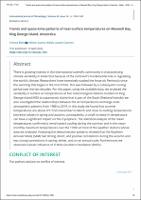Trends and space–time patterns of near-surface temperatures on Maxwell Bay, King George Island, Antarctica
Fecha
2022-04Colecciones
- Artículo científico [176]
Recurso(s) relacionado(s)
https://rmets.onlinelibrary.wiley.com/doi/epdf/10.1002/joc.7661Resumen
There is growing interest in the international scientific community in characterizing climate variability in Antarctica because of the continent's fundamental role in regulating the world's climate. Researchers have intensively studied the Antarctic Peninsula since the warming that began in the mid-1950s. This was followed by a subsequent cooling period over the last decades. For this paper, using the available data, we analyzed the variability in surface air temperatures at five meteorological stations located on King George Island (KGI) (a subantarctic island that is part of the South Shetland Islands); we also investigated the relationships between the air temperatures and large-scale atmospheric patterns from 1968 to 2019. In this study we found that summer temperatures are above 0°C from December to March and close to melting temperatures (extreme values) in spring and autumn; consequently, a small increase in temperature can have a significant impact on the cryosphere. The statistical analysis of the mean temperatures confirmed a trend toward cooling during the summer and in the mean monthly maximum temperatures over the 1990s at most of the weather stations whose data we analyzed. Analyzing the teleconnection patterns showed that the Southern Annular Mode (SAM) had strong, direct, and positive correlations during the autumn and less strong connections in spring, winter, and on an annual scale. Furthermore, we observed a lesser influence of El Niño-Southern Oscillation (ENSO).
El ítem tiene asociados los siguientes ficheros de licencia:








